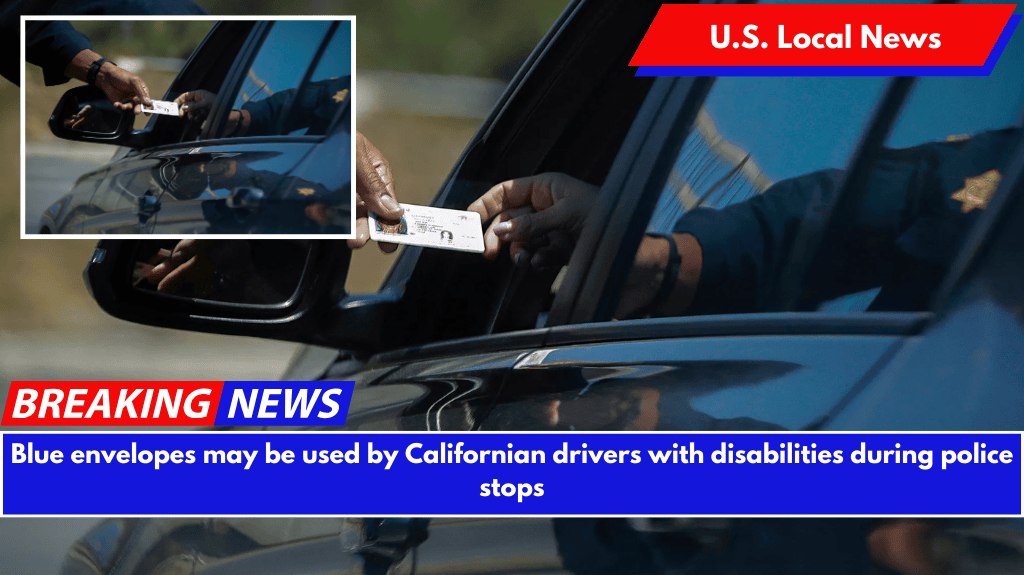Almost everyone feels nervous during a traffic stop, but people with disabilities are particularly concerned about whether an officer understands their condition or may misinterpret their symptoms.
An Inland Empire lawmaker wants to make it easier for Californians with disabilities to deal with police traffic stops by allowing drivers to present law enforcement with special blue envelopes containing vehicle information and disability accommodations.
San Diego launched a blue envelope program in 2023, while Riverside and San Bernardino did so last year. Blue envelopes are also used in several East Coast states, as well as Colorado.
State Senator Rosilicie Ochoa Bogh, a Republican from Redlands, introduced legislation in February to expand the program throughout California.
“It provides preparation and awareness on the public safety side of it but also accommodates and eases the fear and the panic that our constituents with disabilities may have,” according to Ochoa Bogh. “It deescalates the potential of police stops in our state.”
A traffic stop under the program could look like this: an officer stops the driver and requests identification. The driver requests that the person present a blue envelope containing copies of their driver’s license, insurance, and registration, as well as any relevant information about their disability.
The blue envelope signals the officer to slow down and be patient, while also making the driver feel more at ease when interacting with law enforcement.
However, critics raise privacy concerns and claim that the bill lacks the resources required to ensure the program’s successful implementation.
“It would need to be a quality program, and this bill falls short,” stated Beth Burt, executive director of the Autism Society Inland Empire.
Ochoa Bogh’s bill directs the Department of Motor Vehicles to print and distribute blue envelopes containing safety and communication tips for officers and drivers.
They would also include blank spaces for drivers to write down their needs, accommodations, and emergency contact information.
The DMV would provide blue envelopes upon request. Ochoa Bogh acknowledged that some people do not wish to disclose their disabilities; no one would be required to participate.
The bill is scheduled for a Senate Transportation Committee hearing on April 28.
During a traffic stop, some people with disabilities may exhibit behaviors that officers interpret as signs of guilt or defiance.
For example, Ochoa Bogh stated that people with cerebral palsy may exhibit tremors that could be misinterpreted as nervous or guilty behavior. Burt stated that officers sometimes mistake their shaking symptoms for driving under the influence.
People with limited verbal abilities “may take time to process the information and articulate an answer” to an officer’s questions, Ochoa Bogh said, whereas those with physical disabilities may take longer to exit a vehicle.
A traffic stop can exacerbate communication difficulties and exaggerate stims, or reflexive, repetitive movements and other anxious body language, in autistic drivers.
Miscommunication about disabilities has resulted in tragedy. Last year, San Bernardino County Sheriff’s Deputies shot and killed a 15-year-old Apple Valley boy with autism after he charged at them with a garden tool.
According to news reports, it was unclear whether the deputies were aware he had autism, but the family filed a lawsuit alleging civil rights violations.
That is why Burt believes a statewide blue envelope program should cover all public safety encounters, including those involving pedestrians, cyclists, and transit riders, rather than just traffic stops. And she suggested training to ensure that everyone is on the same page.
Officers must learn how to communicate with people with disabilities and how to de-escalate tense situations, she said. People with disabilities and their families must understand how to respond safely during a traffic stop. They also require knowledge of the program’s capabilities and limitations.
“One of our concerns is that families will think it’s a get-out-of-jail-free program; it’s okay that I run a stoplight or get caught speeding because I have a blue envelope,” she told me.
Burt stated that her organization collaborated with San Bernardino County law enforcement and the Inland Regional Center to develop the county’s program, spending $50,000 on merchandise such as envelopes, bracelets, key chains, lanyards, stickers, and seat belt covers to help people communicate about their disabilities. They also offered written materials in several languages.
Burt said she appreciates Ochoa Bogh’s intentions, but a successful blue envelope program requires more time and resources than her bill provides.
“When you’ve got a good quality program, we’ve seen what it does for adults with autism and other disabilities,” she told me. “They feel safe and heard, versus a free program where you would just put the envelopes out with the DMV.”
Last year, Assemblymember Kate Sanchez, a Republican from Rancho Santa Margarita, introduced a similar bill to establish a statewide blue envelope program, which would have cost $8.3 million. The bill failed in committee.
This time, Ochoa Bogh is asking community organizations to help cover the cost of producing and distributing blue envelopes. She stated that establishing a statewide system would ensure consistency for people traveling with disabilities.
“This is a framework that local jurisdictions can work with and modify, so that no one is reinventing the wheel and that there is some commonality between adjacent counties,” she told the audience. “It deescalates, it educates and empowers everybody to have a more amicable interaction.”











